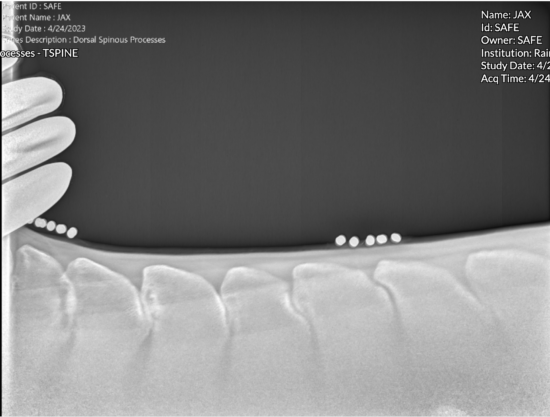As is the case with any new horse, it takes some time before we get to know them. That period of unknowing that comes before knowing is always so strange to reflect on – the hidden personalities that lurk beneath the surfaces, waiting to be teased out by proper care and caring. When 15 horses arrived on our doorstep all at once last November, we knew it would take a bit before we knew each of them.
Jax was one of the first off the trailer. He was immediately kind, letting us flit about him to get his intake vitals and measurements. He had a lip tattoo that he was coy about letting us peek at, but his subsequent dental float allowed us to learn he was only 15 – quite young, and in good physical condition, no reason why he couldn’t be brought along as a riding horse.
And so that’s just what we did. After his intake quarantine was over, we brought Jax into the fold of our horsemanship program, and found him willing and responsive. He faced the same challenges as most of the Graham horses – an initial franticness when asked to move forward, an inability to bend laterally, and a pushiness on the ground – but he was a fast learner, and never felt dangerous. We guarded our hearts a bit as we got to know Jax, knowing that his would likely be a fast turnaround.
But as we spent more time with Jax, we began to notice he could be a little ‘cinchy.’ The issue did not present itself every time he was cinched up, but there were several instances where his reaction to the cinch being tightened was quite dramatic. We called our vets.
Dr Lewis had previously seen Jax for a soundness evaluation, something we put nearly all the Graham horses through in preparation for their restarts under saddle with us. At that appointment, she had recommended shoes for him to help bolster his thin-soled feet, and prescribed Equioxx to help cover the mild hind-end arthritis that is so common in horses of his breed and age. But since the shoes and the meds, he had been doing very well under saddle, and as she palpated along his back at the appointment we’d made for a diagnostic for his cinchiness, we told her so.
Fashion statement of the year: lead jackets, coming to a vet appointment requiring radiographs near you. Technology certainly is amazing, that the time between the X‑ray being snapped and its image appearing on the computer screen is mere seconds. And on that screen, in black and white, was our diagnosis.
Kissing spines, a rather cute name for something painful. If you want to get technical, you could say he has overriding dorsal spinous processes – essentially, the touch or overlap of these DSPs. On radiographs, Dr Lewis identified 5 spots in which Jax’s DSPs overrode one another significantly, making his a moderate case, radiographically. His clinical signs, however, were mild.
Kissing spines is not an uncommon phenomenon, especially, it seems, in thoroughbred horses (one study showed 40% of horses have it to some degree). Some horses who have it never exhibit any clinical symptoms of discomfort or pain, while others, like Jax, only have mild signs that something might be amiss under the hood. Given his diagnosis, we wanted to be sure that we were doing right by Jax, but Dr Lewis told us that, with the appropriate management, it was likely Jax could be kept comfortable as a riding horse going forward. There would be some work involved to help maintain him, but this did not necessarily have to spell the end of his time under saddle.
So then, what next? We scheduled an appointment to have those DSPs injected with a steroid, per Dr Lewis’ suggestion. This injection will be followed by a period of rest, and then gradual strengthening before getting back into the swing of full work. We also made Jax an appointment for some acupuncture, another treatment Dr Lewis recommended. He was a very near perfect boy for this treatment, and seemed to have good responses.
As a more in-house treatment, we will help Jax alleviate some of the pressure off his spine by helping him strengthen his abdominal muscles and stretch out his back through targeted exercise. And of course, proper saddle fit and significant warm up time will also be important going forward.
While there is a surgical option, Dr Lewis has seen equal results with less invasive modalities, so the non-surgical route is how we will proceed at this time.
Until his treatments begin next week, Jax is taking it easy, shedding out in the spring sunshine alongside his buddy, Picasso.





